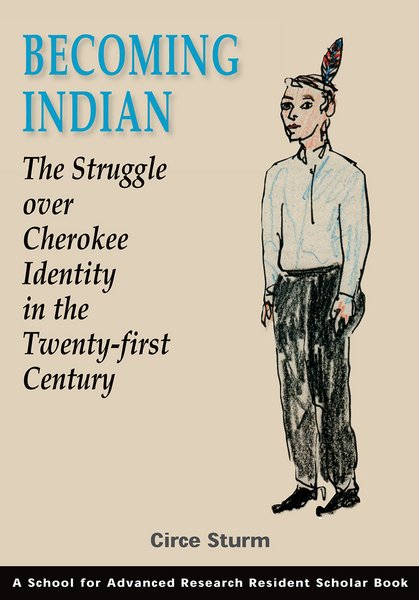Becoming Indian
The Struggle over Cherokee Identity in the Twenty-first Century
Circe Sturm
Sturm examines Cherokee identity politics and the phenomenon of racial shifters: people who have changed their racial self-identification from non-Indian to Indian on the US Census. Many racial shifters include people who have recently discovered their Native American ancestry. Others have family stories of an Indian great-great-grandmother or -grandfather they have not been able to document. Still others have long known they were of Native American descent, including their tribal affiliation, but only recently have become interested in reclaiming this aspect of their family history. Despite their differences, racial shifters share a conviction that they have Indian blood when asserting claims of indigeneity. Becoming Indian explores the social and cultural values that lie behind this phenomenon and delves into the motivations of these Americans to reinscribe their autobiographies and find deep personal and collective meaning in reclaiming their Indianness, a process that reveals much about the shifting politics of race and indigeneity in the United States today.
2011. 280 pp., 2 figures, 1 map, 3 tables, 6 appendices, notes, references, index, 7 x 10
Contributors: Circe Sturm
Awards: Winner of the 2011 James Mooney Award, Southern Anthropological Society; runner-up for the 2012 Robert W. Hamilton Book Award, UT Office of the Vice President for Research and the University Co-operative Society; finalist for the Best Subsequent Book in Native American and Indigenous Studies Prize, Native American and Indigenous Studies Association; finalist for the Book of the Year Award in the Social Science Category, ForeWord Reviews; finalist for the New Mexico–Arizona Book Award, New Mexico Book Co-op
Download an excerpt.
—Orin Starn, author of Ishi’s Brain: In Search of America’s Last “Wild” Indian
“Becoming Indian is an utterly absorbing study of Cherokee associational life in the age of multicultural America. With her engaging style and crystal clear understanding of complex race and social relations, Circe Sturm unveils the intricate motivations of individuals and groups with newly claimed Cherokee identities, as well as the reactions to their claims by members of the three federally recognized Cherokee nations. Sturm develops a novel vocabulary and fresh conceptualizations to describe these ‘racial shifters’ and ‘citizen Cherokees,’ revealing that while often at odds, they do share common epistemological ground.”
—Tiya A. Miles, University of Michigan
“Sturm…explores the identity politics of becoming Indian. Sturm…offers thoughtful profiles of the various groups…who form quasi-tribes. Insightful and thought provoking, this volume is unique in its approach. Highly recommended.”
—Choice, November 2011, vol. 49, no. 03
“In getting beneath the obvious statements and the most apparent problems, Sturm deserves kudos for discussions of white privilege involved in race shifting and performs an excellent analysis of unpacking the ability of such individuals to engage in an endeavor that phenotypic nonwhites would have little ability to enact.”
—Julia Coates, American Indian Studies Center, UCLA, American Anthropologist, 115(4), December 2013
- Opening
- What Lies Beneath: Hidden Histories and Racial Ghosts
- Racial Choices and the Specter of Whiteness
- Racial Conversion and Cherokee Neotribalism
- Shifting Race, Shifting Status: Citizen Cherokees on “Wannabes”
- Documenting Descent and Other Measures of Tribal Belonging
- States of Sovereignty: Tribal Recognition and the Quest for Political Rights
- Closing
- Beyond Red Power: American Indian Politics and Activism since 1900, edited by Daniel Cobb and Loretta Fowler, 2007
- Indian Subjects: Hemispheric Perspectives on the History of Indigenous Education, edited by Brenda Child and Brian Klopotek, 2014
- “Our Indian Princess”: Subverting the Stereotype, Nancy Marie Mithlo, 2009
- Our Lives: Collaboration, Native Voice, and the Making of the National Museum of the American Indian, Jennifer Shannon, 2014
- The Work of Sovereignty: Tribal Labor Relations and Self-Determination at the Navajo Nation, David Kamper, 2010
- “U.S. Native American Population Increased 87% Due to Racial Shifting,” Circe Sturm, Mississippi Free Press, December 17, 2021
